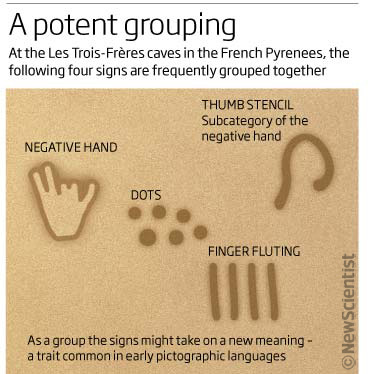Do some cave art markings represent a Paleolithic alphabet?

I’m not entirely sure why we should be surprised that early humans, who could after all paint stunning and complex artworks, were also capable of communicating visually, but hey…
What’s really interesting, however, is this chart, which suggests that their pictographic system was used over a wide geographic area. Was this an ‘internationally’ recognised system, or are these the primal building blocks of visual language?
What emerged was startling: 26 signs, all drawn in the same style, appeared again and again at numerous sites (see illustration). Admittedly, some of the symbols are pretty basic, like straight lines, circles and triangles, but the fact that many of the more complex designs also appeared in several places hinted to von Petzinger and Nowell that they were meaningful – perhaps even the seeds of written communication.
…The real clincher came with the observation that certain signs appear repeatedly in pairs. Negative hands and dots tend to be one of the most frequent pairings, for example, especially during a warm climate period known as the Gravettian (28,000 to 22,000 years ago). One site called Les Trois-Frères in the French Pyrenees, even shows four sign types grouped together: negative hands, dots, finger fluting and thumb stencils (a rare subcategory of the negative hands).
Full story over at New Scientist